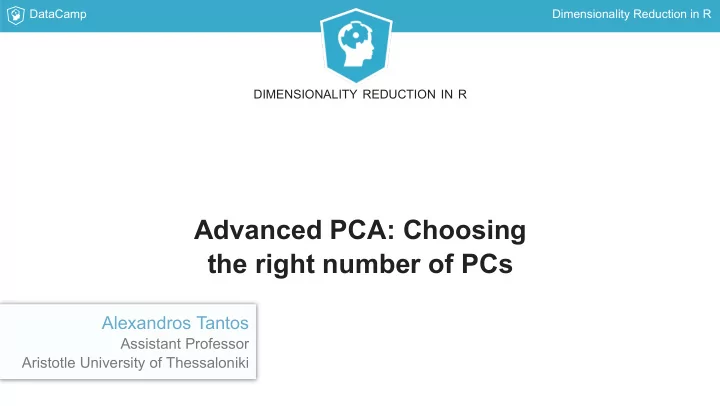

DataCamp Dimensionality Reduction in R DIMENSIONALITY REDUCTION IN R Advanced PCA: Choosing the right number of PCs Alexandros Tantos Assistant Professor Aristotle University of Thessaloniki
DataCamp Dimensionality Reduction in R How many PCs to keep? Earlier: Maybe 2 or 3 ... Stopping rules 1. The Scree test 2. The Kaiser-Guttman rule 3. Parallel analysis
DataCamp Dimensionality Reduction in R The Scree test mtcars_pca <- PCA(mtcars) fviz_screeplot(mtcars_pca, ncp=5)
DataCamp Dimensionality Reduction in R The Kaiser-Guttman rule Keep the PCs with eigenvalue > 1 summary(mtcars_pca) mtcars_pca$eig get_eigenvalue(mtcars_pca)
DataCamp Dimensionality Reduction in R Parallel Analysis library(paran) mtcars_pca_ret <- paran(mtcars_pca, graph = TRUE) mtcars_pca_retained$Retained [1] 2
DataCamp Dimensionality Reduction in R DIMENSIONALITY REDUCTION IN R Let's practice!
DataCamp Dimensionality Reduction in R DIMENSIONALITY REDUCTION IN R Advanced PCA: Performing PCA on datasets with missing values Alexandros Tantos Assistant Professor Aristotle University of Thessaloniki
DataCamp Dimensionality Reduction in R Exploring datasets with missing values library(VIM) sleep[!complete.cases(VIM::sleep),] sum(is.na(VIM::sleep)) 38 Skipping rows with missing values: Risky option that leads to unreliable PCA models. Often costly to ignore collected data.
DataCamp Dimensionality Reduction in R Estimation methods for PCA on datasets with missing values From simplistic to sophisticated methods: Using the mean of the variable that includes NA values. Impute the missing values based on a linear regression regression model. Estimating missing values with PCA Use missMDA and then FactoMineR Use pcaMethods
DataCamp Dimensionality Reduction in R Estimating missing values with missMDA Iterative PCA algorithm Initial step: use the mean for imputing the missing values Conduct PCA on the resulting complete dataset Use the coordinates of the newly-extracted PC s (initially taking the mean) for updating them. Repeat the previous two steps until convergence is achieved. Conduct PCA on the completed dataset with PCA() .
DataCamp Dimensionality Reduction in R Estimating missing values with missMDA library(missMDA) nPCs <- estim_ncpPCA(VIM::sleep) nPCS$ncp 3 completed_sleep <- imputePCA(VIM::sleep, ncp = nPCs$ncp, scale = TRUE) PCA(completed_sleep$completeObs)
DataCamp Dimensionality Reduction in R Imputing missing values with pcaMethods The internals of pca() : Uses regression methods for approximation of the correlation matrix. Compiles PCA models Finally, it projects the new points back into the original space. library(pcaMethods) sleep_pca_methods <- pca(sleep, nPcs=2, method="ppca", center = TRUE) imp_air_pcamethods <- completeObs(sleep_pca_methods)
DataCamp Dimensionality Reduction in R DIMENSIONALITY REDUCTION IN R Let's practice!
DataCamp Dimensionality Reduction in R DIMENSIONALITY REDUCTION IN R N-NMF and topic detection with nmf() Alexandros Tantos Assistant Professor Aristotle University of Thessaloniki
DataCamp Dimensionality Reduction in R N-NMF and PCA Difficult to interpret PCA models with count/frequency data. Normality assumption. PC s include negative values. N-NMF algorithms are able to extract clear and distinct insights from the data.
DataCamp Dimensionality Reduction in R N-NMF: Tearing the data apart
DataCamp Dimensionality Reduction in R N-NMF: Tearing the data apart
DataCamp Dimensionality Reduction in R N-NMF: Tearing the data apart
DataCamp Dimensionality Reduction in R N-NMF: Tearing the data apart
DataCamp Dimensionality Reduction in R N-NMF: Tearing the data apart Objective functions for minimizing: the square of the Euclidean distance Kullback-Leibler divergence
DataCamp Dimensionality Reduction in R Text mining and dimensionality reduction What is topic modeling? Unsupervised approach to automatically identify topics . Topics are cluster of words that frequently occur together. Why is dimensionality reduction important? Data sparseness of frequency data Word co-occurrence Identifies topics with the new r dimensions.
DataCamp Dimensionality Reduction in R nmf() for topic detection BBC's datasets live in: http://mlg.ucd.ie/datasets/bbc.html library(NMF) bbc_res <- nmf(bbc_tdm, 5) W <- basis(bbc_res) H <- coef(bbc_res)
DataCamp Dimensionality Reduction in R Exploring the term-topic matrix W library(dplyr) colnames(W) <- c("topic1", "topic2", "topic3", "topic4", "topic5") W %>% rownames_to_column('words') %>% arrange(. , desc(topic1))%>% column_to_rownames('words')
DataCamp Dimensionality Reduction in R
DataCamp Dimensionality Reduction in R
DataCamp Dimensionality Reduction in R DIMENSIONALITY REDUCTION IN R Let's practice!
Recommend
More recommend